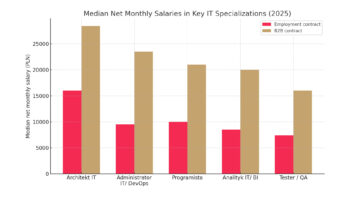Until a few years ago, the IT job market resembled an eldorado. Professionals dictated terms and conditions, companies competed for talent with benefits and pay rises and the demand for digital competences was growing rapidly. Today, the situation is quite different: more and more companies are downsizing, and instead of a boom, the market is in a state of crawling stagnation.
The change is radical – and painful for both workers and businesses. Figures show that redundancies are becoming more common and the pace of technological transformation is forcing adjustments on the labour market that many were not prepared for.
From a market of the worker to a market of uncertainty
The COVID-19 pandemic has accelerated digital transformation. Between 2020 and 2022, companies massively implemented remote solutions, developed e-commerce systems and invested in process automation. The IT industry was the beneficiary of this trend – this was when professionals were free to choose their offers and average salaries grew much faster than in other sectors.
“Not so long ago, employees dictated the terms,” Dr Iwona Jaroszewska-Ignatowska of the law firm People & Law emphasised in Forbes. Indeed, the shortage of programmers or data engineers meant that companies were prepared to pay more and more just to attract talent.
This situation, however, did not last long.
Symptoms of crisis
From 2023 onwards, news of cutbacks became increasingly frequent. Technology giants – from Google and Meta to Amazon – announced massive layoffs, explaining them by the need to optimise costs and focus on strategic growth areas. They were followed by smaller companies, including Polish IT firms.
“We are definitely facing a more difficult moment for many companies. We are seeing a creeping stagnation. Group layoffs are occurring more frequently than two or three years ago,” – said the expert.
Statistics confirm these observations. According to the Dziennik Gazeta Prawna, by mid-2024, county labour offices had received applications for layoffs of more than 80,000 workers – more than in 2020, when the pandemic paralysed the economy.
Economy and technology side by side
There are several reasons for the change. The first is cost pressure. The increase in the minimum wage – currently PLN 4666 gross and from January 2025. PLN 4806 gross – is heavily impacting companies’ budgets.
“Redundancies are often the result of plant closures and the relocation of production abroad, which occurs, among other things, because of the high increase in the minimum wage,” Jaroszewska-Ignatowska explained.
The second factor is technology. Artificial intelligence, which has dynamically entered business in the last two years, is starting to realistically displace some tasks previously performed by humans.
“This is a direct result of the entry of new technologies, above all artificial intelligence”. – the expert pointed out, citing the example of an IT company where up to 80 per cent of the workforce had been made redundant.
AI is changing the employment landscape faster than expected. Tools that automate coding, generate content or analyse data allow companies to cut costs. From the perspective of companies, this is a natural step – from the perspective of employees, however, it means a loss of stability.
Who loses and who gains?
At the forefront of the risk are jobs involving repetitive activities. Automation hits copywriters, marketing or technical support specialists. Some experts point out that the legal professions – hitherto immune to technology – could also experience profound changes due to the development of tools for document analysis and opinion preparation.
This does not mean, however, that the IT labour market is heading for collapse. Its structure is changing. Companies increasingly need specialists in AI model management, data security or cloud deployment. Areas such as cyber security, AI governance or algorithm development are becoming key fields for investment.
New rules of the game
For employees, this means the need to upgrade their skills and be flexible in their approach to their careers. Investing in learning new technologies, certifications and development in areas that are difficult to automate is now becoming an essential condition for remaining competitive in the labour market.
Companies, in turn, need to redefine their business models. Simply providing software services or outsourcing IT is not enough if competitors with lower labour costs and access to automation offer similar quality more cheaply. The opportunity lies in specialised services, high-margin projects and innovative implementations where human competence and AI technology work together instead of excluding each other.
End of the eldorado, beginning of the transition
In just a few years, the IT labour market has moved from a ‘worker’s market’ to a period of profound uncertainty. However, the change is not just a crisis – rather, it is a process of adaptation to new economic and technological realities.
Not so long ago, there was talk of a golden age of IT. Today, the market resembles a testing ground for companies seeking a balance between cost and innovation. This is not the end of the industry, but the beginning of a new era in which those who are quickest to learn to cooperate with technology – rather than compete with it – will win.












